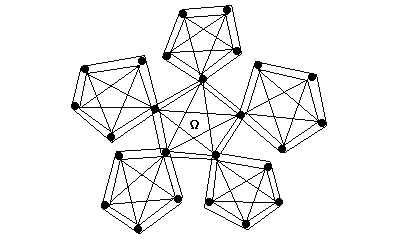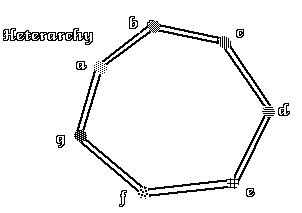This is the fourth article in the Explaining Synergic Organization series.
Timothy Wilken
Major Features
Decision-Action Tensegrities utilizing:
- Decision heterarchy with synergic consensus and veto
- Action hierarchy with synergic negotiation
- Conflict free mechanism
The Ortegrity is a system for organizing two or more humans. It produces win-win relationships between all individuals within the organization. This results in a conflict free environment which optimizes the two processes of human behavior—decision and action. The resultant is that efficiency, productivity, and quality of work-life are optimized.
Decision-Heterarchy
In the Ortegrity, decisions are made in heterarchy. Each member’s role is the same. The goal is to find the plan of accomplishing the assigned task with best effect on all. A win-win solution. This search leads to the most efficient way of doing things. All members are protected from any loss by their veto. Only a win-win plan can be approved. Such plans that will be strongly supported by all members.
Humans develop strong feelings of community in heterarchy. It strengthens their commitment to the organization. Individuals are more creative and enthusiastic in a setting where they feel respected and needed.
Decisions are always made heterarchically. All individuals in a heterarchy sit on the same level. They are equal in authority and responsibility. No one is superior to anyone else. It is the responsibility of all to accomplish the task assigned to the heterarchy. They all have equal authority and equal responsibility to decide how the task will be accomplished.
Anyone can propose a plan as to how the task might be accomplished. The heterarchy continues discussion until a unanimous decision is reached. Only those plans not vetoed carry. Every member has a veto and is expected to use it to prevent losses. This is synergic consensus. It is a powerful system for producing unanimous decision. Remember loss can still occur in synergic organization. But if loss must occur it is minimized and then shared equally by all members of the heterarchy.
The Synergic Veto—life’s secret for efficiency
Most humans are surprised to learn of veto power. It seems very strange in the world of “directed” management. How can the boss allow employees to veto his orders and get anything done?
Members of a heterarchy are not employees. They stand equal with the organizer. A major secret of life is that self-directed organization is much more efficient than other-directed organization. The secret is to transcend directing anyone. The Ortegrity creates the ideal environment for self-organization.
In an environment of self-organization, human potential blossoms. Humans operate at a more powerful level. Those in an Ortegrity soon realize that their well being depends on the success of their organizations. They realize that if they wish to be well paid their organization must be successful. They have high interest in successful solutions to their tasks. They desire to be successful, and they want their organizations to be successful as well.
Now once the members of a heterarchy have decided on a plan of action. They then renegotiate among themselves to divide the plan of action into subtasks.
Recall that all members sit on the same level as “equals”. No one has more authority than anyone else. Everyone has equal responsibility and equal authority within the heterarchy. The assignment for the heterarchy is to find the best plan to accomplish the task so all members will win. It is the collective responsibility of the entire heterarchy to find this “best” solution. Anyone can propose a plan to accomplish the task. All problems related to accomplishing the task would be discussed at length in the heterarchy.
The proposed plan for accomplishing the task would be examined by all members of the heterarchy. Anyone could suggest a modification, or even a completely different alternative plan to accomplish the task—always seeking to maximize the win. All individuals would serve as information sources for each other. The heterarchy would continue in discussion until a plan could be found that worked well for everyone. The goal of the heterarchy is to find that course of action that maximizes the win for everyone, if that is not possible and the group must lose, then the goal becomes to find that action which minimizes loss for everyone. And when loss occurs it is shared equally by all.
Organizing Humans
Those individuals within even today’s organizations are the ones who collectively “know” the most about the organization, and they certainly “know” best how to organize their own skills, talents and abilities .
In an environment of calmness and trust, two heads really are better than one. And it is the veto that lets this all work.
It is the veto that allows for synergic consensus within the Decision-Heterarchy. Synergic consensus requires that all decisions be unanimous. All proposed plans are approved unless they are explicitly vetoed. Any member of the heterarchy can veto any plan in which they or anyone else loses. It is their duty to veto any loss in the system.
Because all loss positions are vetoed, all relationships become win-win. The power of synergic consensus rests on finding the third alternative. A major fact about human performance mental or physical is that it is greatest when the individual is winning. Examine our Olympic athletes or our Nobel laureates. An environment that allows only win-win relationships will produce major increases in efficiency, productivity, and quality of work-life.
We humans are presently conditioned to expect our relationships to be win/lose. We view most situations from that either/or point of view. Either I win or I lose. It has to be one or the other. Synergy science reveals the third alternative. It may be harder to find, but there almost always exists a third way of doing things so no one loses. Or at worst you are assured that the loss has been minimized and equally shared. This distributes the loss so it has the least negative effect on the individual. This is the win-win way—this is synergy.
When all were in agreement and only then would the plan be implemented. The plan must insure that all members of the group win. Any member can veto a losing plan. Taking the time in decision making to discover the win-win way means that action will be many times more efficient.
In most human organizations today, the boss simply assigns tasks or groups of tasks to each of his selected managers. This is other-directed management—telling the managers what to do. The Ortegrity operates very differently. No one tells anyone what to do. All other-direction is replaced with self-direction. Once the heterarchy has synergically decided on a plan of action, the system negotiates to form an action hierarchy. This is the structure used in implementation. Here, each member’s role is different.
Action—Hierarchy
Now once the heterarchy has approved a win-win plan of action to accomplish the Synergic Task, the members of the heterarchy begin to form a action team on a negotiated basis. The individuals within the heterarchy divide labor. Action is too large for any single member. Individual responsibility and authority is agreed to through open negotiation. The action team then functions as a hierarchy to carry out the plan. Participation within the system is always voluntary. The members of the team decide how they wish to work together, or even if they want to participate. No one is ever forced to do anything they don’t want to. However no win can occur unless they are successful.
Individuality is a strong feature of the action hierarchy.
Actions are always made hierarchically. All individuals in a hierarchy sit on different levels. They have different authority and responsibility for accomplishing the task. Their individual responsibility and authority is determined by synergic negotiation. Once having reached a decision in heterarchy they begin an open win-win negotiation to divide the labor of the plan. They develop levels of responsibility and authority. But these levels are voluntarily assumed. Again only a unanimous arrangement is permitted.
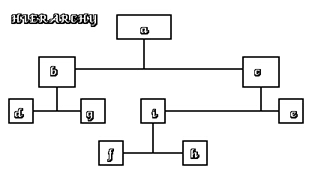
All relationships within a Ortegrity are win-win. This is the first principle of an Ortegrity, and all are pledged to uphold it. This is why every member is required to veto any action within the the system in which he or anyone else would lose. The utilization of synergic consensus and synergic negotiation produces very different forms of heterarchy and hierarchy. The forms used within the Ortegrity are nothing like committees with majority rule, or typical other-directed hierarchies. Heterarchy decides using the mechanism of synergic consensus and veto. And hierarchies are created by synergic negotiation of individual responsibility and authority. Synergic means all must win.
There is a division of labor with the individuals negotiating as to levels of responsibility and authority in terms of implementing the plan. The individuals remain in hierarchy until the task is accomplished. When finished the hierarchy is abandoned and heterarchy reformed to make a new decision.
Ortegrity utilizes a dual mechanism in that everyone within the organization has two identities—two roles. Everyone participates in both decision making and in action implementation. Everyone has both heterarchical and hierarchical functions. The unit of organization within the Ortegrity is the sub-tensegrity—the Decision-Action Tensegrity.
The Rhythm Of Life
During implementation, the action team would continue to function until the task was accomplished, then the action hierarchy is abandoned with all members returning to heterarchy to make a new decision about the next task. this of course leading to the creation of a new action team.
Decision —>Action —>Decision —>Action —>Decision —>
Action —>Decision —>Action —>Decision —>Action —>
Decision —>Action —> and on and on and on …
First it configures as a decision-heterarchy, it then considers its task, then one member declares a plan of action. If there are no vetoes, then the heterarchy configures itself into an action-hierarchy. During the action it functions as a hierarchy. Each member standing where he agreed to stand, performing those tasks he volunteered to perform. Once the action is successfully completed, the hierarchy is abandoned and the members return to the heterarchy.
Heterarchy —>Hierarchy —>Heterarchy —> Hierarchy
—>Heterarchy —> Hierarchy —>Heterarchy —>
Hierarchy —>Heterarchy —> and on and on and on…
As a balanced system of discontinuous hierarchies and continuous heterarchies, the Ortegrity has the strengths of both heterarchy and hierarchy, and none of their weaknesses.
The End of Conflict
This system is designed to eliminate all internal conflict. Elimination of all conflict maximizes efficiency, productivity and quality of work-life. All relationships between all individuals within the system are win-win. This is a design characteristic of the system. It is veto power that forces the third alternative—the win-win solution. It is synergic relationship that unlocks human potential. This is the relationship that eliminates all conflict.

Using the win-win relationship in organizations is like applying grease to machinery. Japanese corporations are presently 150% more efficient and productive than American corporations. Those companies who choose to restructure as Ortegrities could experience an increase in efficiency and productivity of 1000%.
Decision-Action Tensegrities
The organizing unit of the Ortegrity then is the Decision-Action Tensegrity. These are also tensegrities. Synergic organization utilizes a tensegrity of tensegrites.
The D-A Tensegrity is a group of between two and twenty humans. The size of a D-A Tensegrity is limited by the complexity of decision making. In a complex area such as in research & development, the ideal size may be six or seven members. In a system with simpler decision making as many as 16 to 20 individuals may form a production D-A Tensegrity.
During decision making the D-A Tensegrity uses the heterarchical form. A heterarchy with seven members is a base seven tensegrity. A two member heterarchy would be called a base two. A three member heterarchy is a base three and so on.
The following illustration of a base seven D-A Tensegrity represents the heterarchical relationship on the perimeter and the hierarchical relationships with direct lines of communication. All individuals have a dual identity. Their heterarchical role in decision and their hierarchical role in action.
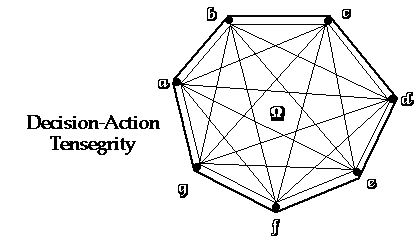
The organizers using synergic consensus will determine how to structure their Ortegrities. There is no right or wrong way. The way that insures the maximum win and prohibits loss is the best way for a particular system. I expect Ortegrities will be as diverse as life forms.
The “organizer” does not direct the other members of his group. He would instead be responsible for coordinating their organization into an effective team.
The “organizer” begins by presenting the synergic task to the individuals within the heterarchy.
An Ortegrity divides itself into synergic groups in order to function. We can call these groups Decision-Action Tensegrities. Heterarchy is used when making decisions and hierarchy when carrying out actions. Each Decision-Action Tensegrities has an “organizer” that functions as coordinator-leader. When the group is making decisions, he/she coordinates the heterarchy. When the group is taking action, he/she leads the hierarchy. Decision-Action Tensegrities can have two to twenty or more members.
StartUp Ortegrity
A StartUp Ortegrity begins when a single individual commits to using the synergic mechanism of the O.T. to accomplish some goal or set of goals that are beyond his/her abilities as an individual.
The primary organizer first sets about recruiting one or more other individuals to help him or her. The primary organizer will begin by sitting down in heterarchy with the primary group and define the primary task using synergic consensus and veto. The members of the primary Decision-Action Tensegrity all have equal responsibility and equal authority in reaching synergic consensus and defining the primary task.
They discuss things fully. Any member of the group can propose a change to improve or refine the primary task. Only those modifications which find support from all members of the group are implemented. Anyone can veto any proposal in order to prevent loss, or offer a modification to insure a greater win. Only those proposals unanimously agreed to carry.
Once the primary synergic task is defined and unanimously elected by the heterarchy, then a plan for synergic action must be developed using synergic negotiation. Now the members of the heterarchy will accept hierarchical roles with individual responsibility and authority. If the primary synergic task is within the ability of the primary Decision-Action Tensegrity to accomplish it,then they accomplish it operating in action-hierarchy. When they are done, they reconfigure back into decision-heterarchy to define their next synergic task.
If however, the synergic task is too large for the primary Decision-Action Tensegrity to accomplish, then part of the primary synergic task will be to make the Ortegrity larger. This is accomplished by having the primary members recruit and organize secondary D-A Tensegrities.
Top Down Self-Organization
Once all members have agreed to a primary plan of action, they then divide it into smaller secondary plans for distribution among themselves. This results in the self-assignment of tasks. The members of the primary tensegrity, then divide labor through the voluntarily formation of a action-hierarchy to implement the plan. Each “organizer”, the term “manager” is scraped altogether, then takes his task down to the secondary tensegrity which he is responsible for organizing.
The pattern of organization is from the top down. This is not the “other-directed” hierarchy of American Capitalism. The process of organization is from the top down, but the mechanism is “self directed” heterarchy. Only when synergic consensus has been achieved at the higher level can the organizational focus move down to a lower level.
Within the Ortegrity, most “organizers” will function at two levels of tensegrity. Within the primary tensegrity, they are “organized” by the primary “organizer”—the synergic alternative to a CEO. In addition these members are also the “coordinators” of their own secondary tensegrities which they are responsible for organizing.
Within the Ortegrity, those individuals operating at two levels are then both organized and organizers. As members of the primary tensegrity, they are organized by the “primary organizer”—the O’ (called the O prime) and they are also the organizers of their own secondary tensegrities. Each of these is therefore an “organized-organizer”—the O-O (called the double O).
An organization can have any number of Decision-Action Tensegrities. These Decision-Action Tensegrities can be on different levels. Large organizations would include several levels of Decision-Action Tensegrities. These different levels are referred to simply as first level, second level, third level and so on in synergic terminology.
Compound Tensegrities
The following illustration is of a base five, level two O.T.. Twenty five employees with one five-member primary DA-Tensegrity and five (five-member) secondary DA-Tensegrities.
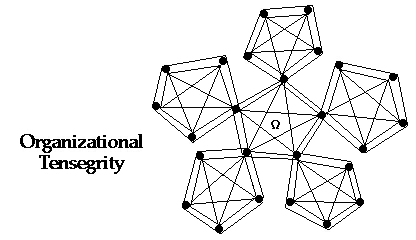
The central Ω DA-Tensegrity is the primary Tensegrity. It divides the primary tasks of the company into secondary tasks, these are then carried down to the secondary Tensegrities for solution by the O-Os, “organized-organizers”. In this example the O’ functions as both primary organizer and one of the O-Os.
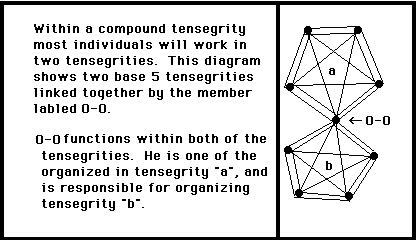
Ultimately Flexible
No known system of organization is more flexible and adaptive then Living systems. The Ortegrity is a pattern of life.
The Ortegrity is ultimately flexible. There can be two to twenty individuals within the base D-A Tensegrities. Bases can be regular—all with the same number of members or irregular—all with different numbers of members or any mixture of regular and irregular.
There can be any number of levels, and any number of branches on each level. The system is so powerful that twelve levels looks like enough for most of our needs.
The following chart is based on a base seven regular tensegrity. All DA-Tensegrities would have seven members.
| 1 | 1 | 7 |
| 2 | 8 | 49 |
| 3 | 57 | 343 |
| 4 | 400 | 2401 |
| 5 | 2801 | 16,807 |
| 6 | 19,608 | 117,649 |
| 7 | 137,257 | 823,543 |
| 8 | 960,800 | 5,764,801 |
| 9 | 6,725,601 | 40,353,607 |
| 10 | 47,079,208 | 282,475,249 |
| 11 | 329,554,457 | 1,977,326,743 |
| 12 | 2,306,881,200 | 13,841,287,201 |
A level 12 Ortegrity would be adequate for organizing the entire humans species within a single organization. Recalling that the larger a tensegrity the more powerful it will is. Synergic science predicts this will also be true for human organizations structured as Ortegrities. Therefore, I would expect a trend towards very large organizations.
Imagine, what could be possible if the entire human species were a single organization. No conflict, no wars, no crimes. Is there anything we could not accomplish?
